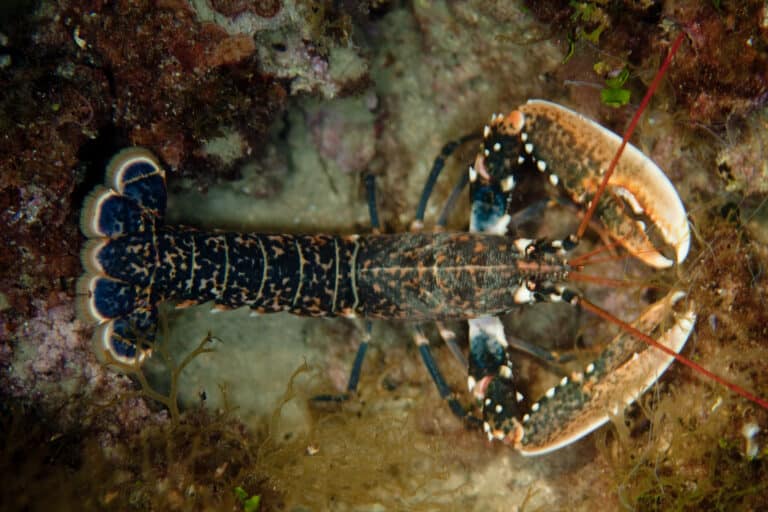How To Tell If Salmon Is Bad? Learn the Signs of Spoiled Salmon
Do you love salmon? If you do, then chances are high that you often buy this popular oily fish. But have you ever experienced losing track of the date or the sell-by date when you purchased salmon? And because you have absolutely no idea how to tell if salmon is bad, you simply threw the fish away.
Salmon will always be up there in the list of the most popular fishes. I think salmon is one of my top three favorite seafood. However, let’s face it– there are times when we just forget when we bought a particular food, especially when food like salmon and other fish are stored in the freezer.
Signs of salmon that has gone bad

Salmon and asparagus on the plate
There are several ways to determine if salmon has gone bad and shows signs of spoilage:
1. You can start by looking at it
- Fresh salmon has a very distinct pink or orange color. As such, you’d know that salmon has gone bad when it looks very pale. Its scales look dull, while the gills have a dark color.
- Salmon that have gone bad usually have dark spots or mold on the flesh. In certain cases, the spots are whitish in color. The discoloration on the flesh of the fish is another indicator that salmon is no longer safe for consumption.
- In case the salmon that you bought has its head on, then examine the eyes. Fresh salmon have bright eyes with dark pupils. It should also be bulging a bit. Bad salmon has dark and discolored eyes.
- Fresh salmon has those white lines that are very easy to distinguish. Those lines can help keep the firmness of the fish. But eventually, those lines will separate. Thus, you can tell that the salmon has gone bad when the familiar white lines have disappeared.
2. How it smells
- Another indicator of bad salmon is its smell. While salmon has that distinctive mild scent, a fresh one doesn’t have an intensely fishy odor. If the salmon that you stored for a long time in the freezer has a strong, pungent fishy odor that smells like ammonia or rotten eggs, it is probably gone bad!
3. How it feels
- High-quality salmon should be a nice firm, bouncy texture – the flesh should not be mushy, slimy, or sticky; it is probably spoiled. Also, spoilt fish looks so fragile when you handle it.
4. How it tastes
- Overly fishy, metallic, or sour-tasting salmon is probably bad and should be thrown out!
It is possible that even though salmon looks and smells fine but is improperly stored, it could be spoiled! Eating bad salmon can give you food poisoning/illness, and if you aren’t sure if your salmon is good, it is best to err on the side of caution and throw it out!
How to properly store salmon?

Salmon in the plastic bags
Storing salmon incorrectly would absolutely cause the salmon to spoil quickly.
How would you extend the shelf life of salmon and prevent it from turning bad? There are several ways for you to do so.
The best way to extend its shelf life is to freeze the salmon rather than store it in the refrigerator. Wrap it in a sealed plastic bag, then place it in the coldest part of the freezer. I would typically put it against the freezer wall. Avoid placing it near the door lid because the temperature in that area tends to fluctuate, especially when the freezer is opened now and then.
In storing fresh salmon and preserving its quality and flavor, it is essential to remove all the air from the plastic wrap or store it in a freezer-safe bag/vacuum-sealed bag. Doing so can prevent freezer burn.
Raw salmon can keep its best quality for 2-3 months when stored in the freezer. While you can still cook or consume raw salmon frozen for more than 3 months, the quality isn’t the best though.
You can then thaw the frozen salmon in the fridge overnight before cooking it. But salmon thawed in cold water must be cooked right away.
Storing salmon at room temperature is a no-no. Bacteria can grow quickly at temperatures of 40 – 140 degrees Fahrenheit, and consuming spoilt salmon could cause food poisoning (resulting in symptoms like nausea/vomiting and diarrhea). I would err on the side of caution and discard salmon left out at room temperature for more than 2 hours.
How to cure salmon?
Another way to prolong the storage life of salmon is to cure it. Curing is ideal if you want to use salmon in a few days, but don’t want to go through the freeze and thawing processes. I usually cure salmon 3 days before using it.
Ingredients

Fresh salmon and vegetables on the plate, and slices of the lime
- Two and a half cups of cold water
- One-third cup of white sugar
- One-half cup of salt
- One pound of salmon fillet, remove bones
Step-by-step guide

A cup of water and spoons of salt
- Whisk the salt, water, and sugar together in a bowl. Continue doing so until the salt and sugar have dissolved.
- Cut the salmon in the middle of the fillet but not through the skin. Before the knife reaches the skin of the salmon, twist it to your right so that you can cut and remove the skin from the meat.

slices of salmon and a knife on the chopping board
- Repeat this cutting method for the remaining side, then cut each fillet into slices of about ¼ inch thick.
- Soak the salmon slices s in the brine for about 3 minutes. Remove them afterward and gently blot with paper towels.

slices of salmon and slices of lemon
- Place the salmon on a plate, cover it with plastic wrap, and refrigerate overnight.
- You can also sprinkle the fish with spices like thyme.
That’s it. You now have cured salmon you can smoke or cook in the next few days.
Read Related Article: What Is the Number One Cause of Spoiled Meat?
Conclusion
There are ways to tell if salmon has spoilt by looking, smelling and touching the fish. If you are unsure if the fish is bad, best to err on the side of caution and throw the fish away.
But as long as you properly store salmon in the freezer, then the chances of it going off are very slim! Curing salmon is also another way to extend its shelf life.
See Related Article: How Can You Tell if Pork is Spoiled?






